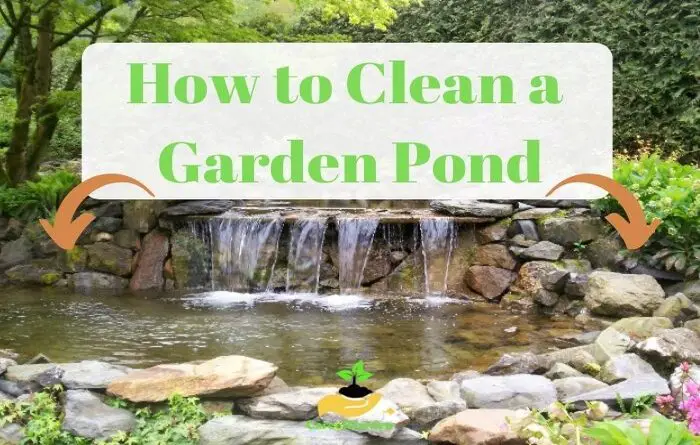How to Clean a Garden Pond [In 3 Easy Ways]
It’s time to clean the garden pond and don’t know how to do it? Don’t worry, if you follow this article there is an easy way to keep pond water clean. Keeping your pond water clean naturally is easy and you can enjoy your pond without too many complications.
A garden pond houses a fragile ecosystem, which should be maintained in order to ensure its balance. Indeed, there are several factors that threaten its vitality, starting with the stagnation of water, which favors the appearance of algae and the formation of sediments. Oxygen becomes scarce and the survival of the fish in the pond is threatened.
On the other hand, the proliferation of certain aquatic plants or algae can become a problem. This is the case with microalgae or filamentous. The same can be said in relation to the excess of fish: due to their excrement, the water is loaded with nitrates and favors the development of algae that reduce the oxygen index of the aquatic environment.
The evaporation of water and the increase in its temperature is another risk factor. These examples illustrate the fragility of this small ecosystem and show how essential it is to clean and maintain your garden pond.
Constant maintenance is the key to the attractiveness of a garden pond for a long time and in this article we will show you how to clean a garden pond.
Rules to follow before cleaning your garden pond:
- Install a forced circulation water filter with gravel or sand fill. It will allow you to get rid of small debris and will saturate the water with oxygen. In the warm season, the device should work around the clock.
- Equip your pond with sides made of stone or concrete. the height of the fence should be at least 30 cm above the ground and 10 cm deep, so that earthworms do not fall into it after heavy rains. In the water, they die, and their remains decompose, causing harm to the permanent inhabitants of the reservoir.
- Remove large floating debris daily with a net. It spreads over the entire surface of the pond, flooded with weights and then drags along the surface of the water, collecting debris.
- Remove debris that accumulate at the bottom using a normal cleaning net as well. A vacuum cleaner will greatly facilitate this daily work.
- The surface of the water in the garden pond should not be exposed to the bright sun all day, preferably no more than 5-6 hours a day.
- To avoid increased evaporation of liquid and loss of oxygen, which will inevitably lead to waterlogging, the pond is specially shaded by planting low ornamental shrubs along the banks. If the pond is located in an open area, in hot weather it is covered for several hours a day with material that does not let in sunlight.
- On hot days, the water level drops rapidly due to evaporation. Add the required amount of fluid regularly. This will ensure a consistent salt balance, which is essential for proper plant growth and development.
Methods of cleaning a garden pond
Methods of cleaning a small garden pond can be divided into groups:
| How to clean a garden pond: |
|---|
| 1. Physical (manually) |
| 2. Chemical |
| 3. Biological |
| 4. UV (ultraviolet radiation) |
Each of these options depends on the degree of pollution of the pond, its size, the presence of ornamental plants and other individual parameters.
How to clean a garden pond manually
These are the simplest and most common cleaning methods used by pond owners.
Before starting to clean your garden pond follow this rules:
- If there are fish, frogs or other specially populated inhabitants, catch them and transplant them into a separate container.
- Remove ornamental plants if possible.
- Drain all the water.
- Clean the bottom and all interior surfaces of silt and other debris.
- Fill the pond with water, return the plants to their original places.
Fresh water can quickly become cloudy after a complete replacement. Do not be afraid of this – this is how the work of microorganisms manifests itself, which quickly multiply in a clean reservoir.
After a couple of days, the water will clear on its own, and in another week, when the ecosystem balance is restored, it will be possible to return fish, snails and other inhabitants to the pond.
Steps how to clean a garden pond:
1. Remove string algae with a net or by hand.
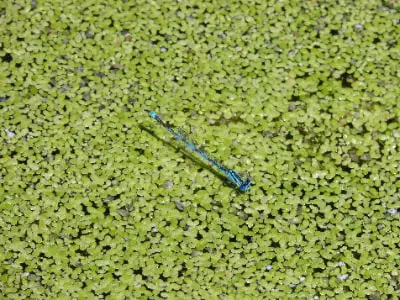
The string algae can accumulate on the pond surface and clinging to the pond walls. This algae will harm the pond’s ecosystem. Using a brush or a skimmer net to remove the algae. In case you are wondering skimmer nets can be purchase from a home improvement store.
You can also pull the algae out with your hand but a net will help you reach a bigger area of the pond. The algae can be safely disposed on the compost bin as long as it is not made of materials such as plastic, glass.
2. Treat the water from the garden pond
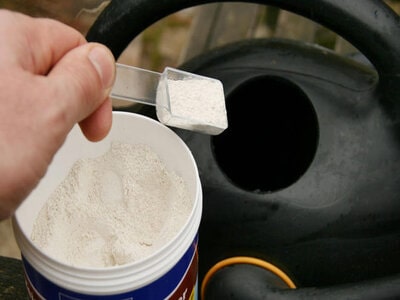
Another alternative to cleaning the pond from string algae is to use hydrogen peroxide. To prepare a pond cleaning solution add half a gallon (2 L) of hydrogen peroxide for every 1000 gallons (3785.4 L) of pond water. To protect the fish and the plants from the pond do not overuse hydrogen peroxide.
Use barley straw which can be bought online. Sometimes you can find barley straw bale for pond and if not fill the barley straw into a mesh bag or a hay net and leave the bag in the pond for several weeks.
Leave the straw net into the pond for a few weeks and after that don’t forget to remove any rotter straw. This will prevent adding for nutrients to the algae. The recommended amount of barley straw for pond cleaning is approximately 8 oz. per 1,000 gallons of wate
If the water has a difficulty flowing through the filter now is the time to clean it using the filter’s owner manual.
3. Prepare the pond for draining.
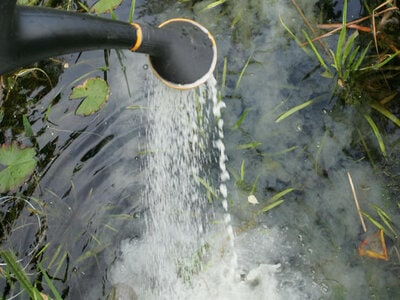
If you want to reach the sludge and the mud at the bottom of the pond you need to drain the water. This requires to remove also the fish and plants to avoid injuring them. Start by setting up a tank or a water container for them. Set up enough tanks to contain them all and keep the water tanks in a shady location.
Fill the tank with pond water but if the water is too cloudy use tap water instead. An important tip is to make sure that the water temperature in the tank is constant to prevent the fish going to thermal shock.
Another alternative is to remove only about 75 % of the water from the pond using a sludge vacuum so you don’t have to remove the fish. However it is recommended if the pond has not been cleaned for a long time and the water has completely tipped over, you must completely empty the pond.
4. Pump the water pond into a large water container.
Utility pumps can be found at home improvement stores. Follow your owner’s manual to install them near water. Connect them with a hose to a large container that will hold lake water, such as a bathtub or pond. Make the pond as large as possible to contain fish and plants too, if you plan on using it as a pond.
5. Vacuum debris from the bottom of the pond.
To perform this step you need to have a pond vacuum because it has long handles which reach the bottom of the pond. This pond vacuum can be found online or at home improvement stores.
Take the pond vacuums and start removing decaying plant matter, mud and sludge from the bottom of the garden pond.
If you have worked on all areas with the scrubber, the pond water should now have a significant amount of mud and the exposed areas should appear a little cleaner.
Depending on the degree of pollution, the sludge is only available in small or large quantities. Now use the sludge vacuum cleaner for the loosened sludge. Do not be surprised that a lot of pond water can be lost at the same time.
6. Clean the vegetable matter from the garden pond.

For tanks that can be handled manually, the sludge from the bottom of the tank can be removed by sweeping with a broom and shovel or shovel. Dispose of trash in the trash.
Garbage removal is carried out manually or using special tools and equipment. Of course, it is easy to remove leaves, grass and branches floating on the surface with your hands, a net, and wipe the greens from the walls and shallow areas of the bottom with a brush, but these are only “cosmetic” measures.
After cleaning, you should also check your pond for dead plant parts. Remove these before you put the green back into the pond. You dispose of the dead plant parts and the sludge on the compost.
7. Clean the garden pond liner residue.
Usually you have to wait 24 to 48 hours before refilling the pond after cleaning the pond, this is a good time to check the pond liner for possible cracks and if you discover one mend it with glue and some pond liner.
If you don’t like the look of your garden pond this is a good time to remove the pond liner residue. Using a brush soaked in water try to loosen any slime residue.
You can see algae like a carpet covering the lining. This alga, as long as it is in the lining, protects against discolored water.
8. Return everything to the pond.
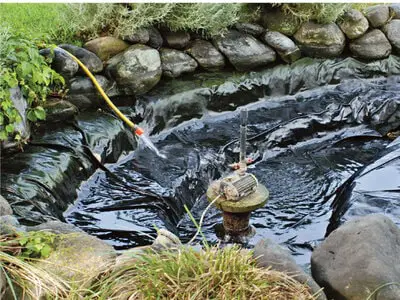
Slowly fill up the pond 24 to 48 hours after cleaning. First the plants are planted and then the fish. Filling in the water too quickly is not recommended, as otherwise the temperature of the water cannot adjust. You can also identify suspended matter that you can fish off with a skimmer.
Gradually pump back the water from the stored tank into the garden pond 24 to 48 hours after cleaning. In is not recommended to fill the water too quickly because the temperature of the water cannot be adjusted properly and also you can also identify suspended matter that you can fish off with a skimmer.
When everything is finished put the fish back into the pond. If the pond water you want to replace is too cloudy use rainwater of non-chlorine tap water instead. You can collect rainwater using barrels under roofs gutters.
If however you want to use tap water please mix it with water from the tank to prevent it being to cold for the fish. You have completed the pond cleaning procedure and you can enjoy your garden pond again.
Filtration equipment needed to clean your garden pond
Most often, for the cleaning of garden pond the owners install pressure or flow filters, which differ in their principle of operation:
| Type | Operating principle | Advantages |
| Pressure head | The pump, located at the bottom, pumps water under pressure into the filter tank, where first the brushes and sponges trap dirt and plant debris (mechanical cleaning). Then, passing through the filler of mineral biogranules, the water is biologically purified. The built-in ultraviolet sterilization lamp ensures the destruction of harmful microorganisms. Purified water is also pumped back under pressure. | Simplicity of the device, compact size, ease of use. Suitable for reservoirs with slides, steps and streams, as it can supply purified water up to a height of 2 m. Three-stage filtration system. |
| Flow-through (external) | Installed on the shore (above the water level). Water is supplied to the filter using a pump, and after cleaning it returns by gravity. | High productivity, long service life. Carries out mechanical, biological and ultraviolet (in the presence of a UV sterilizer) cleaning of large reservoirs. |
To maintain the cleanliness of the surface of the pond are Filters – skimmers, suction water, and collecting all the garbage in your cart. At the place of placement, they are bottom, coastal (built-in) or floating.
In order to regularly get rid of dirt, algae and silt deposits on the bottom, some people, who are not too limited in financial resources, purchase special vacuum cleaners – “sludge suckers” with manual or automatic control.
Hand-held devices are well suited for cleaning small and medium-sized ponds from silt with an irregular shape and embossed bottom. They are supplied with various functional attachments and a garbage bag.
In the presence of filtration systems, the use of skimmers and sludge pumps, the owner’s job is reduced to timely maintenance of the equipment: replacing cartridges (depending on the model), washing filters and cleaning garbage collection tanks.
How to clean a garden pond by season
As we have seen before, the quality of the water also depends on the sunlight and the temperature. Maintenance will be different depending on the season of the year.
| Spring | Your filtration system is usually off at this time of year. As soon as the water temperature reaches 10 °C, you should restart it, making sure everything is working properly. Prune and trim the plants around the pond and along the banks. Plant new ones, if necessary. Clean the surface and dispose of dead leaves and other deposits with the help of a pond net. If there are fish in your pond, check their health. Restore the water level in the pond if necessary. |
| Summer | This is the time of year that requires the most work for garden pond cleaning. Clean your filtration system regularly, its nozzles (if you have water jets or fountains) and check the correct operation of the different devices. Check the oxygen level once or twice a month (once a week if you have fish) and take the opportunity to check the pH. Regularly clean the surface of the pond of algae and leaves or floating deposits. Prune the plants. If you have fish, check their health. Repeat the water level as many times as necessary. |
| Autumn | It is time to prepare for winter. It cleans the filtration system for the last time and more specifically, performs a thorough cleaning for its hibernation. As soon as the water temperature drops below 10 °C, turn it off. Feed your fish more regularly, so they can stock up during the winter. If possible, spread a net across the surface of the pond to prevent dead leaves from falling to the surface of the water. Complete the water level for the last time. |
| Winter | Winter is a dormant period for your pond. The fish have a slow activity and the plants have stopped growing. Cut the plants one last time if necessary and protect them from frost. Regularly collect the dry leaves from the surface (with a leaf catcher or install an anti-leaf net). Stop feeding the fish. Stop the filtration system (if you haven’t already) as soon as the water drops below 10 °C. If you get the chance, cover the surface with a plastic or tarp cover to prevent freezing. |
How to clean a garden pond chemically
Chemicals are practically not used in the cleaning of garden pond inhabited by plants and fish. Aggressive preparations based on chlorine compounds, of course, will help to quickly cleanse the pond from algae (including beneficial ones), without affecting the acid balance of the water.
However, they will significantly reduce the content of active oxygen, which is necessary for the respiration of fish and other living creatures, and the decomposition of ballast and harmful substances (waste products and toxic nitrogen compounds) by aerobic bacteria.
Preparations containing bromine are considered the safest, but their use without chlorine reagents is ineffective.
Sorption cleaning
An acceptable chemical method is sorption purification using porous minerals zeolites of natural or synthetic origin, with the help of which phosphorus and ammonium can be removed from water.
Sorbents are placed in the chambers of flow-through filters or simply scattered along the bottom at the rate of 0.5-1 kg per volume of 1000 liters for operation for 1 year.
Liming
To accelerate the decomposition of organic pollutants in the pond, increase the oxygen content in water, disinfect it from harmful bacteria and parasites, use slaked or quicklime and ground limestone.
The choice and dosage of the agent depend on the method of application (by water or on a dry bed), the composition of bottom sediments, the pH level of water and soil.
For disinfection of a garden pond, it is considered optimal to apply quicklime in an amount:
- 1 kg/10m2 by water,
- 0.5 kg/10m2 by dry bed.
Preventive liming with water is usually carried out from May to the first half of June with a frequency of every two weeks, at the rate of 0.1 kg/10m2.
Slaked lime and crushed limestone are taken 1.3 or 1.8 times more, respectively.
Garden bugs are difficult to remove but this tutorial I wrote will help you succeed!
Biological methods for cleaning the garden pond
For biological cleaning of ponds in personal garden, use:
- Bacterial preparations such as JBL FilterStart Pond, Starter-Bacterien, etc., which are added to the filter substrate. They begin to act instantly, decompose bottom sludge, destroy harmful nitrogen compounds;
- Algenkiller, Aqua Balance, Prudochist, etc. They cause the death of microscopic green algae, inhibiting the process of photosynthesis. It is available in powder or liquid form. Can be scattered over the surface of the water or simply poured into a body of water. Validity period is about 6 weeks.
Advantages of biological products used for clean your garden pond: speed of action, effectiveness, safety (provided that the instructions are followed).
Disadvantages: relative high cost, changes in the composition of water, which requires the parallel use of drugs that reduce the concentration of methane and hydrogen sulfide, regulate pH and enrich water with oxygen, or aeration with special devices, which further increases the cost of treatment.
4. Clean the garden pond using UV (ultraviolet radiation)
Devices operating in the sterilizer mode and preventing the activation of the vital activity of the smallest algae and other harmful microorganisms are ultraviolet lamps that can be immersed in water.
The UV method is simple, efficient and safe for cleaning garden pond and is popular with small pond owners. However, it should be borne in mind that ultraviolet irradiation does not help to clean the reservoir of large debris and bottom sediments, therefore, the method should be used in parallel with the others listed above.
Traditional methods of cleaning the garden pond
To create a natural ecosystem and constantly maintain the garden pond in good condition, experienced owners plant the bottom and coastal zone of the pond with such plants as nymphaea, elodea, fontinalis, arrowhead, calamus, hornwort, marsh iris, cattail, reeds. In most cases, these are not purchased seedlings at all, but specimens dug out near the nearest river or swamp.
Planting material (rhizomes) is often planted in ceramic pots, which are placed on the bottom. As winter approaches, the pots are moved deeper so that the plants do not die, even if the reservoir is completely frozen.
Some owners also advise to maintain the natural ecosystem of garden ponds:
- to populate reservoirs with small river fish (for example, crucian carp), snails or freshwater crustaceans (daphnia)
- keep in water mesh containers filled with sphagnum moss or peat tablets
- periodically lower a bunch of fresh willow twigs, peeled of leaves into the pond
Conclusion
In a garden pond, you have to recreate an ecosystem, a balance between aquatic flora and fauna. If it is broken, the fish die and the algae proliferate to the detriment of the ornamental plants in the pond.
Knowing how to clean a garden pond allows you to maintain this balance and allow you to get the most out of your garden ponds.
Frequently Asked Questions
How do you know when it’s time to clean the water in your garden pond?
You can determine the need for cleaning your pond by the following signs:
- Too much sediment collects at the bottom.
- The water with fish becomes very cloudy, which is especially noticeable in the summer.
- A “film” appears on the surface of the reservoir, ooze and duckweed in large quantities, underneath there are too many blue-green algae.
- Bad smell.
When do you need to change the water?
In some situations, when the condition of the water has seriously deteriorated, experts recommend not to waste energy on its purification, but to completely replace it with a new one. At the same time, it will take time to settle down, and the microflora necessary for the normal functioning of the fish has appeared in it. It is believed that this process takes at least one season.

